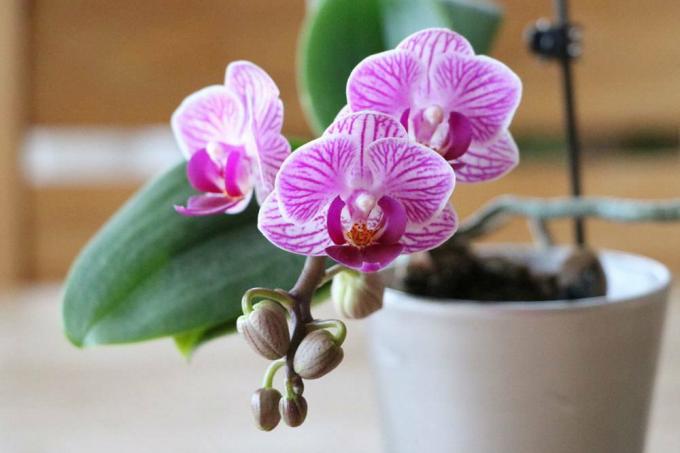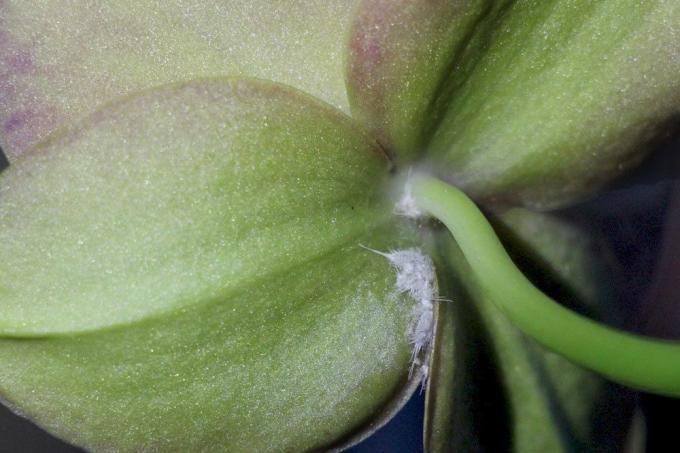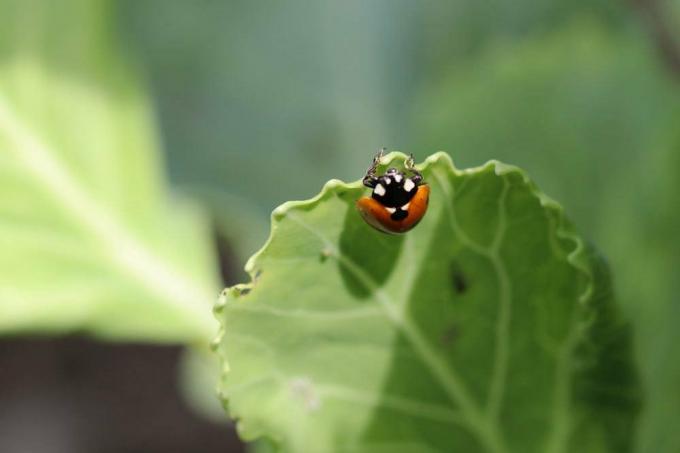
table of contents
- Mealybug
- Recognize mealybug infestation
- Get rid of mealybugs
- Quarantine: the first sensible step
- suitable home remedies
- Showering
- alcohol
- Solutions with soft soap
- Rapeseed oil-water emulsion
- Neem oil
- Ecological means from the trade
- Predators as hard-working helpers
When the buds of an orchid open, filigree flowers in the brightest colors emerge. As if shaped by an artist to last forever. And in fact, every flower stalk makes us happy for several weeks at a time. Unfortunatelly it is Orchids popular not only with us humans. Mealybugs also appreciate these delicacies. They diligently suck the sap until there is nothing left of it. Is there a gentle way to fight them effectively?
Mealybug
Do mealybugs have to be controlled specifically?
First off, the mealybug is known by several names:
- The actual name is mealybug
- because of the woolly hair it bears the name wool louse
- it is a species of scale insect
- Scale insect, mealybug or mealybug: three names, one pest
Mealybugs have developed sucking on plants to perfection. It doesn't take long for all of the sap to flow. The crowd does it, because the more mealybugs attack the orchid, the faster they complete their destructive work. The only solution is that
explosive growth this Pests to fight and get rid of the already existing specimens as quickly as possible. Then, and only then, can orchids be saved. They may be weakened, but with time and proper care they will recover.Recognize mealybug infestation
How do you recognize a mealybug infestation?
If a mealybug cannot be overlooked while casually looking at the orchids, it is usually too late. These pests have to be discovered and recognized much earlier in order for control measures to have any chance of success. Scale insects leave visible tracks that need to be read.
- small white cotton balls on and under the leaves
- In the leaf axils there are delicate white webs
- Buds and leaves appear crippled
- brownish spots
- prematurely wilting leaves and flowers
- sticky leaves from the excreted honeydew
- Soot mushrooms like the honeydew
- recognizable by the black discoloration of the leaves
Where do mealybugs come from anyway?
Mealybugs often come as an uninvited companion newly purchased plant in our living rooms or in the garden. They continue to multiply there and weaken the infested plant more and more. But that's not all, you will soon discover the healthy plants in the neighborhood. You have to fight them as quickly as possible, otherwise they will attack and destroy one plant after the other. In particular, locations with little light, dry and warm heating air and incorrect fertilization make the orchids close inviting delicacies for the mealybugs, who feel particularly comfortable under these conditions and accordingly diligently multiply.
Get rid of mealybugs
Quarantine: the first sensible step
Regardless of whether only the signs of the infestation are recognizable, or whether the mealybug can be seen on the orchids with the naked eye, the infested plant must be removed from healthy plants immediately isolated will. This avoids the high risk of infection. The actual fighting can then begin at their new location.
Home remedies or do you prefer chemistry?
In the early phase of the infestation, mealybugs can be effectively controlled with many home remedies. A home remedy is more environmentally friendly than a chemical insecticide and should be used as a priority. If used properly, home remedies are also gentler on orchids and usually much cheaper than insecticides. However, the work involved is also greater than with a chemical agent. Labor savings would also be the only reason to grab the chemical bottle straight away. If the infestation is very advanced, the home remedies are of little help. But neither does chemistry.
If the orchid can no longer be saved, it should be brought to the attention immediately residual waste be disposed of.
suitable home remedies
Showering
Water washes away the mealybugs
The cheapest and most harmless method for the orchids is to rinse the lice away with a hard water jet. In order not to put the orchid under water, you should proceed as follows
- Pack the pot of the infested orchid in a waterproof plastic bag
- Rinse off exposed parts of the plant with lukewarm tap water. The harder the orchid variety, the harder the water jet it can tolerate
- Turn the orchid upside down and rinse again thoroughly
- Dab the leaves with a soft cloth so that no limescale stains form after they have dried
- then remove the plastic bag from the orchid pot
This home remedy is particularly effective against the young brood of pests. Adult mealybugs cover themselves with a protective layer Wax layerthat the water rolls off well. You have also bitten into the plant, so that even a hard jet of water will not work. So do not stop at this measure, it is not enough on its own to completely control the mealybugs.

tip: If your tap water contains a lot of lime, it is better to use a pressure sprayer with decalcified tap water or rainwater.
alcohol
Alcohol attacks adult mealybugs
Alcoholic solutions have active ingredients that can dissolve the wax layer of the mealybugs. Without this layer, the alcohol works even further and also damages the "exposed" mealybugs.
- Moisten a cloth with alcohol and use it to wipe all the leaves
- Don't forget the subpages
- hard-to-reach places must not be left out
- Cotton swabs dipped in alcohol are helpful here
- Repeat application every 2-3 days
- until all symptoms are gone
Butterfly orchids have robust leaves and can withstand multiple alcohol baths well. But other hard-leaved species are also predestined for this home remedy. However, caution should be exercised with orchids, which have softer leaves. If you have any doubts as to whether you will survive the procedure well, you should use another home remedy.

Solutions with soft soap
Scientific studies show that soft soap solutions more effective Many insecticides act against mealybugs. But unlike chemicals, this agent does not pose any health risks for the user.
- Dissolve about 30 grams of core or soft soap in one liter of water (warm, decalcified water is best)
- add a few dashes of spirit
- Pour the cooled mixture into a hand spray bottle
- Thoroughly spray the orchid, do not miss a single spot
- Put a transparent plastic bag over the orchid and close it tightly, the lack of fresh air increases the effect of the soap solution
- Repeat the treatment every 2-3 days until it is clearly certain that there are no more mealybugs alive
- Spray again after 14 days, as the eggs of these pests are not destroyed by the soap solution and new mealybugs can hatch
tip: Curd soap finely grated with a household grater dissolves more easily in water. Depending on the type of soap, the consistency of the solution can be too thick to spray. Simply add some warm water to dilute.
Rapeseed oil-water emulsion
Cover the pesky pests with a mist of rapeseed oil and water in a ratio of 7: 3. There is no longer any escape for the mealybugs. You should consider the following when fighting:
- Add 1% soft soap solution as an emulsifier
- only treat hard-leaved orchids with it
- Spray the top and bottom of the leaves
- Sun exposure is unfavorable
- therefore spray in the evening
- Place the orchid in a shady place
- Do not spray rapeseed oil solution more than 3 times
tip: Paraffin oil can also be used instead of rapeseed oil. The ideal composition is 12 grams per liter of water.

Neem oil
Neem oil stops the larvae from developing
The oil is pressed from seeds of the neem tree and is a purely natural agent. Nevertheless, special care is required when handling it, because direct skin contact can lead to allergic reactions to lead. The oil can be bought in specialist shops. When using the device, follow the manufacturer's specifications. Remain consistent in the application, so that the reproductive cycle of the mealybugs is effectively interrupted.
Ecological means from the trade
If you don't have time to make your own spray solutions, you can now discover some ecological remedies against mealybugs in stores. Because these also contain household remedies such as rapeseed oil, soft soap and the like. Let us advise you which of these is best for you.
Predators as hard-working helpers
Ichneumon wasps, ladybirds and lacewing larvae are not welcome guests in living rooms. In doing so, they fight Beneficial insects Mealybugs whenever they cross their path. However, if the orchids are thriving in a greenhouse, this type of biological control is well worth considering. You can find some reference addresses for these hard-working helpers on the Internet.






